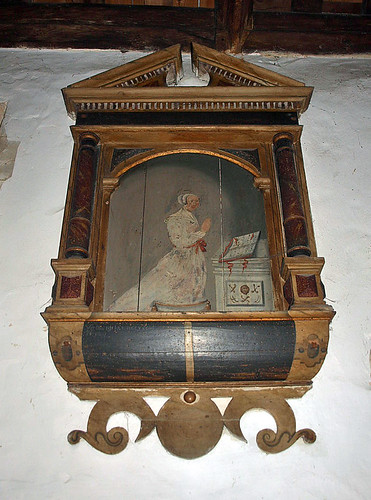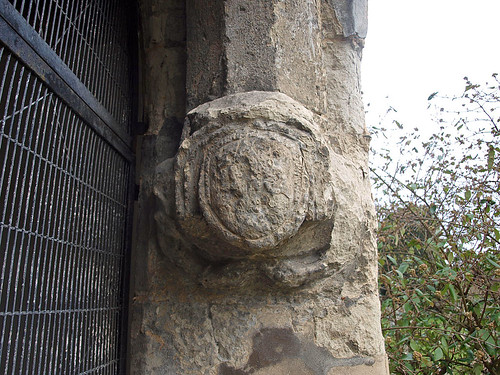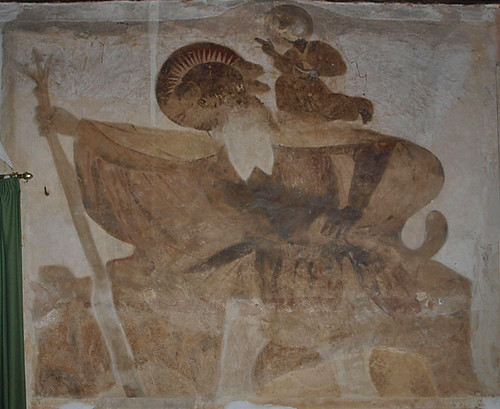ST MARGARET. Flint and pebble rubble. Large blocked Norman window in the chancel N wall and jambs of more in the E wall (group of three?). Remains of a further Norman window in the nave S wall close to the E end. This was replaced by a finely moulded C13 arch, The rest of the arcade is also of the C13 and impressive in its length and the closeness of the piers to each other. Seven bays, on the N side with piers alternately circular and octagonal, double-chamfered arches. On the S side the piers were replaced by a curiously bleak design. It may be C17. The tower-arch is Perp as is the whole W tower. Outside it is decorated by three niches round the W window. Battlemented top. The doorways are C13 on the S side (altered, but remains of the fine moulded arch), C14 on the N (double-chamfered; no capitals). The S porch doorway is of a bold design with two big heads to carry the arch - C14. The aisle windows and the clerestory all Perp and renewed. The Perp parts may be connected with an indulgence of 1447 to rebuild the church. - ROOD SCREEN. Single-light openings with ogee arches and Perp tracery above them. - PARCLOSE SCREEN. Remains in arch to the S chancel chapel; perhaps C17 Gothic. - BENCHES with poppy-heads. - PAINTING. Remains of C13 painting on the Norman window reveal in the nave and the C13 piers of the N arcade. - Late wall painting of St Christopher, N aisle. Magnificently bold movement, C15. - E of this Martyrdom of St Erasmus, badly preserved. - N aisle E wall traces of censing angels. - MONUMENT. Sir Thomas Revett d 1582. Two big kneeling figures. The praying-desk between them uncommonly broad so that small relief figures of children are carved on it ; broken pediment with achievement.
CHIPPENHAM. Charming with red roofs, spacious ways, and lovely trees, it lies near a patch of undrained fen where the true fen plants still grow. Near the church are quaint cottages with long gardens, and an equally quaint brick school of 1714.
It was here, at the home of Admiral Russell in the park, that our first King George was entertained by the admiral, who at La Hogue in 1692 won the first great success of the British Fleet since the destruction of the Spanish Armada; and it was in an older house here that Charles Stuart was kept for a while after the raid on Holmby House, the king being very pleasant and cheerful, we are told, taking his recreation daily at tennis and delighting much in the company of Colonel Joyce.
The church is as charming as the village, and wears the dignity of age unspoiled. At the sides of the 15th century porch are heads so huge that they almost touch our shoulders as we enter, and if we prefer to go in through the 500-year-old tower we open an ancient door in a doorway carved with roses. Seen from under the tower arch, the interior makes a most attractive picture, the avenue of battered 14th century arches ending with the fine arch of the chancel. The arcades are in seven bays, the pillars round and clustered and eight-sided, delightful in their oddness. The oldest masonry is in the chancel wall, where there is a big Norman arch, and a small Norman doorway with a carved medieval door. There are old benches with poppyheads, and a beautiful 14th century screen with its canopy gone, leaving the traceried bays like a delicate arcade. Over the entrance are angels, and among the little carvings are lions and grotesque faces.
A finely preserved monument to an Elizabethan family shows Sir Thomas Revet kneeling in armour opposite his two wives, and four children kneeling below. Another of the 17th century is of wood painted to look like marble, and has the figure of a woman at a prayer desk. It covers an old wall-painting of St Michael weighing a soul, and the figure of Mary can be seen dimly at one side. Among other remains of painting are crude masonry patterns and a patchy St Christopher.
Near the porch lies Sir Thomas Erskine May, who was Clerk of the House of Commons and became Lord Farnborough just before he died in 1886. A learned lawyer and parliamentarian, he was also the author of a standard work on the Constitutional History of England. A sculptured bust of him by Bruce Joy is in the House of Commons.
It was here, at the home of Admiral Russell in the park, that our first King George was entertained by the admiral, who at La Hogue in 1692 won the first great success of the British Fleet since the destruction of the Spanish Armada; and it was in an older house here that Charles Stuart was kept for a while after the raid on Holmby House, the king being very pleasant and cheerful, we are told, taking his recreation daily at tennis and delighting much in the company of Colonel Joyce.
The church is as charming as the village, and wears the dignity of age unspoiled. At the sides of the 15th century porch are heads so huge that they almost touch our shoulders as we enter, and if we prefer to go in through the 500-year-old tower we open an ancient door in a doorway carved with roses. Seen from under the tower arch, the interior makes a most attractive picture, the avenue of battered 14th century arches ending with the fine arch of the chancel. The arcades are in seven bays, the pillars round and clustered and eight-sided, delightful in their oddness. The oldest masonry is in the chancel wall, where there is a big Norman arch, and a small Norman doorway with a carved medieval door. There are old benches with poppyheads, and a beautiful 14th century screen with its canopy gone, leaving the traceried bays like a delicate arcade. Over the entrance are angels, and among the little carvings are lions and grotesque faces.
A finely preserved monument to an Elizabethan family shows Sir Thomas Revet kneeling in armour opposite his two wives, and four children kneeling below. Another of the 17th century is of wood painted to look like marble, and has the figure of a woman at a prayer desk. It covers an old wall-painting of St Michael weighing a soul, and the figure of Mary can be seen dimly at one side. Among other remains of painting are crude masonry patterns and a patchy St Christopher.
Near the porch lies Sir Thomas Erskine May, who was Clerk of the House of Commons and became Lord Farnborough just before he died in 1886. A learned lawyer and parliamentarian, he was also the author of a standard work on the Constitutional History of England. A sculptured bust of him by Bruce Joy is in the House of Commons.



No comments:
Post a Comment